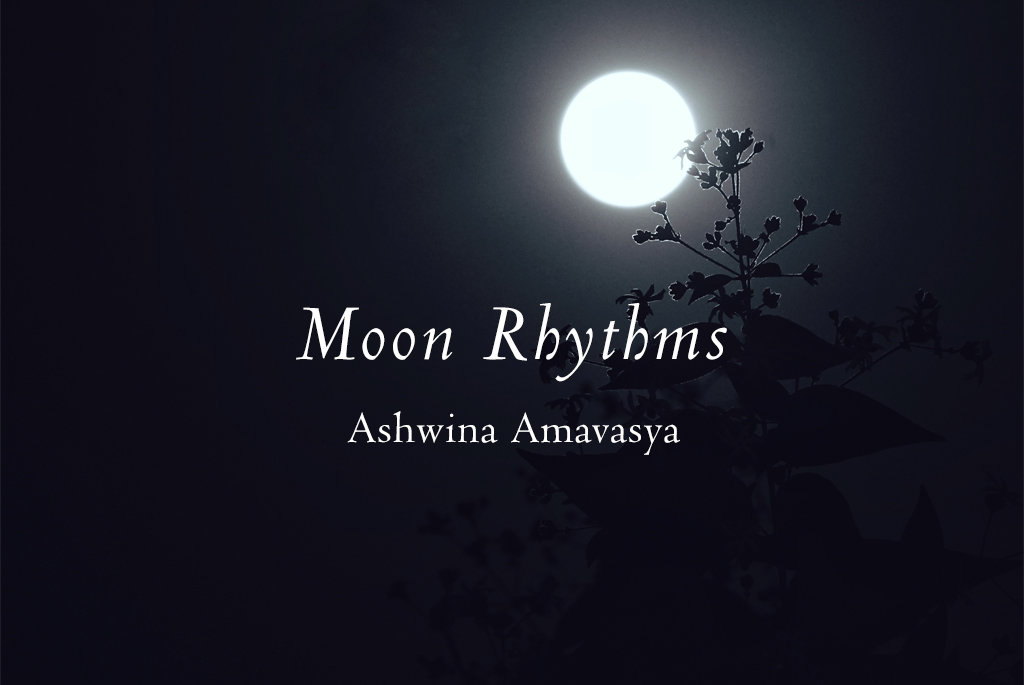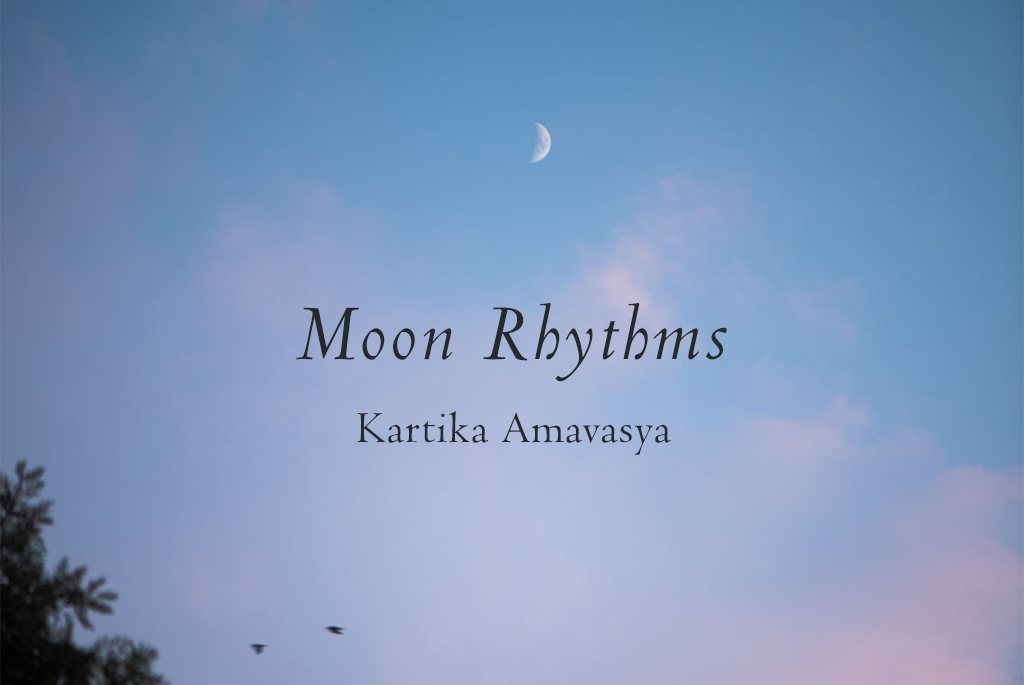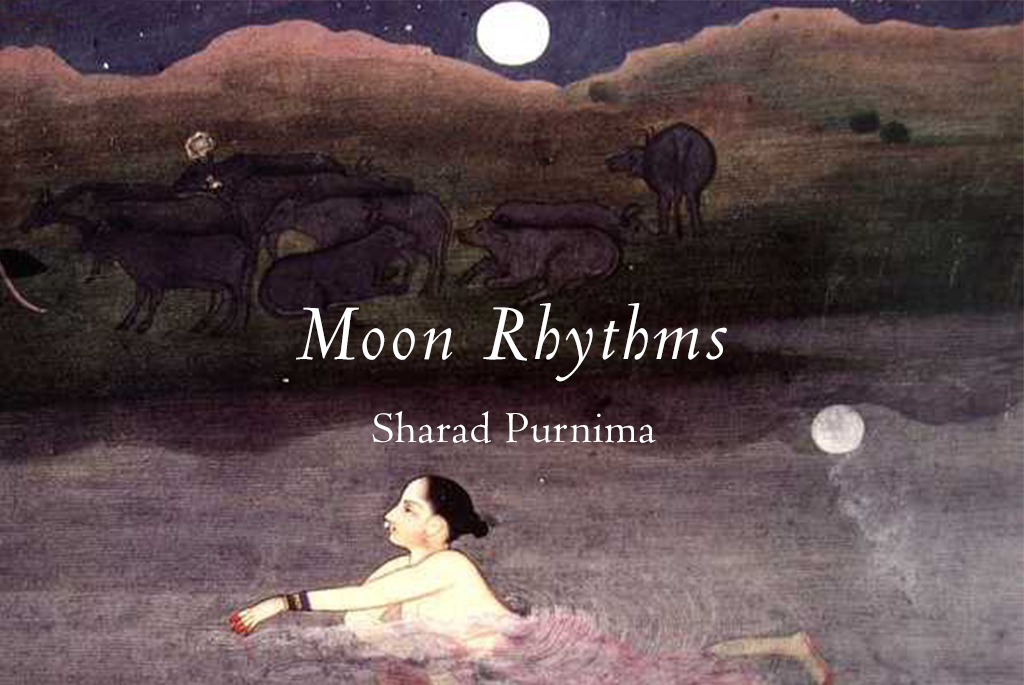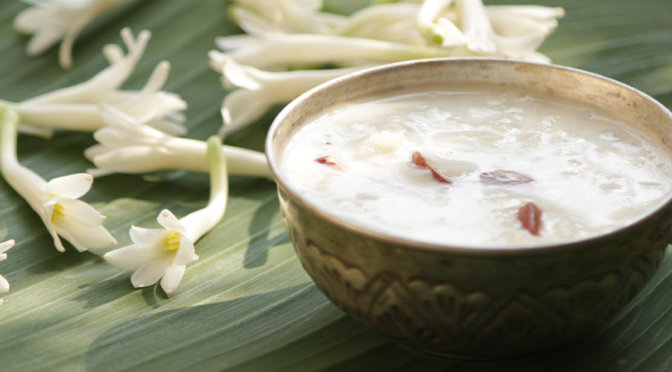




Sharad rtu, the most celebrated of the 6 seasons of the Indian subcontinent, is the season of festivals and is considered a time of beauty, grace and benevolence. And the apotheosis of this season of beauty and grace is the Full Moon of the month Ashwina, also celebrated as Sharad Purnima.
A Full Moon of grace and beauty, Sharad Purnima is a much mythologised night. Of all the Purnimas, this is the Moon that is said to display all of the 16 kalas or aspects of the Moon. The clarity of the autumnal skies allows for the radiance of the Moon to shine unencumbered. Sharad Purnima marks the end of the Ashwina month and the exact mid-point of Sharad rtu. Across the subcontinent this radiant Moon of Sharad is worshipped, observed and celebrated in different ways.
Kaumudi & the Lover’s Moon: Sharad Purnima finds its most stunning and evocative visual representation in the paintings that depict Raas Leela. On this night Krishna entices Radha and all the gopis into the lush forests around Vrindavan, by the banks of the river Yamuna. And by the lilting notes of Krishna’s flute, bathed by the silvery moonlight, showered by the softly fragrant rain of Harsingar flowers, all the sakhis and gopis of Krishna experience the grace and enchantment of the Blue God, dressed in his Pitambari clothes. And so the Sharad Purnima is also celebrated as the Lover’s Moon in the subcontinent.
The soft moonlight that glimmers and bathes them all in its radiance on this night is thought to be so perfect and magical that this night’s Raas Leela is also the celebration of Kaumudi, which means ‘the shine of the Moon or moonlight’. Legend has it that the moonlight on this night offers the grace of healing the hearts and the minds of those who moon bathe.
Kojagiri: Kojagiri literally means, ‘who is awake?’. Lakshmi, the goddess of abundance and wisdom, seeks all those who have stayed awake in a vigil to her on this night and then blesses them. And thus, Sharad Purnima is also celebrated as a night dedicated to Lakshmi and called Kojagiri Purnima. This festival of the Moon is observed in many parts of the subcontinent – Orissa, West Bengal, Maharashtra, Jharkhand and many regions of eastern India.
A significant aspect of the Kojagiri festivities is moon bathing – sitting outside under the moonlight in almost all the regions where this Moon is worshipped and celebrated. But in some regions, the Moon is not viewed directly. Instead its reflection is to be seen in a vessel filled with milk. The origins and significance of this tradition remain to be explored. In Maharashtra this night is also the night for honouring the oldest child in the house. In Orissa this festival is dedicated to Kartikeya, the son of Shiva and Parvati, and older brother of Ganesha. In Bihar’s Mithila region the courtyards of houses are decorated with elaborate Alpanas or Aripans in intricate patterns, made using rice flour paste. The household gods are then brought out into the courtyards and worshipped ritually. Alpana to welcome Lakshmi are also a part of the Kojagiri celebrations in Bengali households. In Bengal this is the time of Lokhi Pujo, where Lakshmi is worshipped not as ‘Dhan Lakshmi’, the bestower of material wealth but as ‘Dhanya Lakshmi’, the bestower of bountiful grains. Because Kojagiri is also a traditional harvest festival, when gratitude was expressed to the divine feminine (as mother Earth, as the nurturer, as the giver of bountiful harvests) given for full granaries that would ensure survival in the starkness of winter season. And for the Kojagiri celebration Lakshmi was traditionally worshipped not as an idol but in the form of a ‘Shora’ or ‘Paut’, which is a clay disc in red upon which the images of the goddess were painted.

Food Rituals: Food is an integral aspect of all festivities in the subcontinent. Even in traditions where the Full Moon is observed by ritual fasting, food has its own space. Water, Milk, Coconut Milk and Rice Kheer are some of the offerings with which the Full Moon is honoured. Typically, these are to be left out under the moonlight for a few hours or the whole night before being consumed. It is thought that the beneficial healing grace of moonlight thus infuses the food, which is later consumed as prasad. Silver, the metal of the Moon, is preferred for the vessels being used to keep the food under the moonlight. In the Mithila region, there is also a beautiful ritual of food designed to keep away Alakshmi, who brings with her poverty and is the older sister of Lakshmi. Since Alakshmi prefers spicy food, a plate of spicy food is kept outside the house so that she may have her fill and leave without entering the house. Inside the house sweet Kheer is kept as an offering to Lakshmi, as she prefers sweets. In some parts of Bengal, little boats made from Banana leaves, and filled with rice grains, symbolising a bountiful harvest, are also a part of the celebrations. Typically, the goddess is also offered five grains on this night.
Perhaps in these rituals of food offerings to the goddess lie the remnants of an ancient harvest festival. At a time when we lived by light and the rhythms of the Sun and the Moon, Full Moons were times of magic and markers of transitions. Sharad Purnima is the night of almost magical beauty in the season of grace. But it also marks the passing of time – telling us that the halcyon grace of Autumn is now giving way to the onset of the darkness and quietude of winters.
Extremely informative & interesting ????
Beautifully written
Loved reading this, please keep posting more
Very beautifully written.. I was hoping to read a little more with context of today’s world. But otherwise beautiful.
This is such a wonderful piece written and something which everyone should know about so that they do not remain untouched with the idea behind each ritual our diverse culture brings in. Absolutely fab!!
Thank you ????????